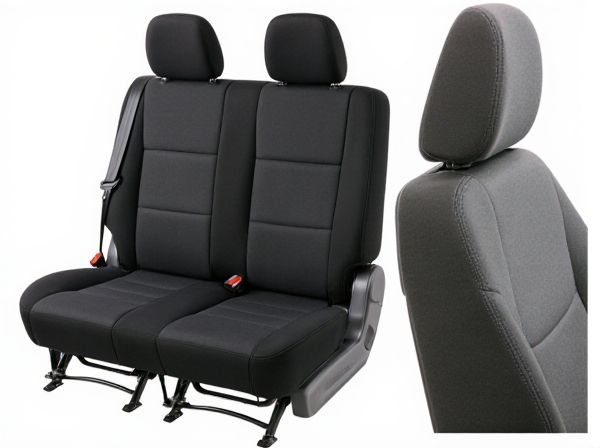
Photo illustration: Fixed Back Seat vs Reclining Seat
A reclining seat offers enhanced comfort by allowing you to adjust the backrest angle to suit your preferred posture, whereas a fixed back seat remains stationary, providing consistent support without customization. Fixed back seats are often favored for their simplicity, durability, and ease of maintenance. Choosing between these options depends on your need for adjustable comfort versus straightforward functionality.
Table of Comparison
| Feature | Fixed Back Seat | Reclining Seat |
|---|---|---|
| Comfort | Standard comfort, fixed position | Enhanced comfort with adjustable backrest |
| Adjustability | No adjustability, rigid back support | Multiple reclining angles available |
| Space Efficiency | More rear passenger space, no extra mechanisms | Consumes extra space due to reclining mechanism |
| Cost | Generally lower cost | Higher cost due to added functionality |
| Maintenance | Minimal maintenance required | Requires periodic maintenance for reclining mechanism |
| Use Case | Ideal for compact cars and basic rear seating | Best suited for premium models and long travel comfort |
Introduction to Fixed and Reclining Seats
Fixed back seats offer a sturdy, immovable design that provides consistent support and enhanced safety during travel or use in vehicles and furniture. Reclining seats feature adjustable backrests that allow users to customize their seating angle for increased comfort and ergonomic benefits. Understanding the differences between these two types helps in selecting the appropriate seat based on user preferences, space constraints, and functional requirements.
Key Differences Between Fixed and Reclining Seats
Fixed back seats provide consistent support with a rigid backrest angle, ensuring stability and simplicity ideal for shorter trips or budget vehicles. Reclining seats offer adjustable backrest angles for enhanced comfort, allowing passengers to customize their seating position, especially beneficial during long journeys. Key differences include the level of comfort, adjustability, and complexity of the seat mechanism, with reclining seats typically incorporating more advanced features and increased weight.
Comfort Comparison: Fixed vs Reclining Seats
Reclining seats offer enhanced ergonomic support by allowing adjustment of the backrest angle, promoting better spinal alignment and reducing fatigue during long drives. Fixed back seats provide consistent support but may cause discomfort over extended periods due to their rigid position, lacking adaptability to individual comfort preferences. The ability of reclining seats to accommodate different seating postures significantly improves overall comfort compared to fixed back seats.
Safety Considerations of Seat Types
Fixed back seats offer enhanced safety by maintaining a stable seating position, reducing the risk of injury during sudden stops or collisions. Reclining seats can compromise occupant protection as their altered angles may decrease the effectiveness of seat belts and airbags. Vehicle safety standards often favor fixed seats in rear positions due to their proven ability to provide optimal crash protection.
Installation and Adjustment Features
Fixed back seats offer straightforward installation with a secure mounting system that typically requires fewer tools and less time, ensuring stability but limited customization. Reclining seats feature more complex installation processes, often involving additional components for the reclining mechanism, allowing users to adjust the seat angle for enhanced comfort. Adjustment features in reclining seats provide variable positioning options, unlike fixed back seats which remain static once installed, catering to personalized ergonomic preferences.
Space and Legroom: Fixed vs Reclining
Fixed back seats typically offer more consistent legroom since the seat position remains stable, maximizing usable space, especially in compact vehicles. Reclining seats provide adjustable seatbacks, enhancing passenger comfort but potentially reducing overall legroom when tilted backward. Space efficiency often favors fixed seats for passengers prioritizing legroom, while reclining seats balance comfort with a slight trade-off in available space.
Maintenance and Durability Factors
Fixed back seats generally require less maintenance due to their simpler design and fewer moving parts, reducing the likelihood of mechanical failures. Reclining seats, while offering enhanced comfort, incorporate complex mechanisms that may need regular lubrication and occasional repairs to maintain smooth operation. In terms of durability, fixed back seats often outlast reclining models because their robust structure withstands wear and tear more effectively over time.
Cost Implications of Each Seat Type
Fixed back seats typically cost less to manufacture and install due to their simpler design and limited adjustment mechanisms, making them a budget-friendly option for vehicle interiors. Reclining seats involve more complex engineering and additional components, such as adjustable frames and motors, which increase production and maintenance expenses. Maintenance and repair costs for reclining seats also tend to be higher from wear on moving parts and potential motor malfunctions.
Ideal Use Cases and Environments
Fixed back seats provide superior support and are ideal for tasks requiring consistent posture, such as office work or gaming setups where stability is key. Reclining seats offer adjustable comfort and are best suited for relaxation environments like home theaters, long-distance travel, or workplaces emphasizing ergonomic flexibility. Choosing between fixed and reclining seats depends on balancing the need for firm support versus customizable comfort in specific use scenarios.
Conclusion: Choosing the Right Seat for Your Needs
Choosing between a fixed back seat and a reclining seat depends on comfort preferences and usage scenarios. Fixed back seats offer stability and support ideal for short trips or vehicles with limited space, while reclining seats enhance comfort on long journeys by allowing adjustable seating positions. Prioritize your typical travel duration and ergonomic needs to select the seat type that best suits your lifestyle and vehicle configuration.
 caratoz.com
caratoz.com